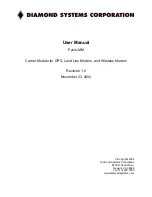
Design detail
The main functions of the AVR are as follows:-
Potential divider
takes a proportion of the generator output
voltage and attenuates it. Provision is made to allow the
attenuation ratio to be adjusted by the internal AVR ‘Volts’
potentiometer or an external hand trimmer if required.
Quadrature droop
circuit converts the current input from a
CT into a voltage which is phase mixed with the sensing
voltage. The result is a net increase in the output from the
sensing network as the power factor lags, causing the
reduction in excitation needed for reactive load sharing of
paralleled generators.
RMS converter
converts the AC signals from the potential
divider into a DC signal representing the Root Mean Squared
value of the wave form.
Summing circuit
provides an interface between the AVR and
accessories, usually a power factor controller, allowing the
accessory output voltage to be summed with the sensing
voltage for control purposes.
Power supply
components consist of transformers resistors,
regulator diodes and smoothing capacitors to provide the
required voltages for the various electronic circuits.
Precision voltage reference
is a highly stable temperature
compensated voltage reference used for dc voltage
comparison purposes.
Soft start circuit
overrides the precision voltage reference
during run up to provide a linear rising voltage.
Amplifier
compares the sensing voltage to the precision
reference voltage and amplifies the difference (error) to
provide a controlling signal for the power device.
Stability circuit
provides adjustable negative ac feedback to
ensure good steady state and transient performance of the
control system
Power control driver
controls the conduction period of the
output device using pulse width modulation techniques.
Power control devices
vary the amount of exciter field
current in response to the error signals produced by the
amplifier and power control driver.
Sync circuit
provides a short pulse to synchronise the Under
Frequency Roll Off (UFRO) and power control circuits to the
generator cycle period.
UFRO
circuit measures the period of each electrical cycle and
reduces the reference voltage linearly with speed below an
adjustable threshold. A light emitting diode (LED) gives
indication of under-speed running.
Engine relief
or load acceptance circuit provides adjustment
for increasing the voltage roll off (gradient of V/Hz slope), to
aid engine recovery after the application of a block load. A
“Dwell” feature is included which delays the rate of recovery of
generator volts after application of load, providing further
engine assistance.
























